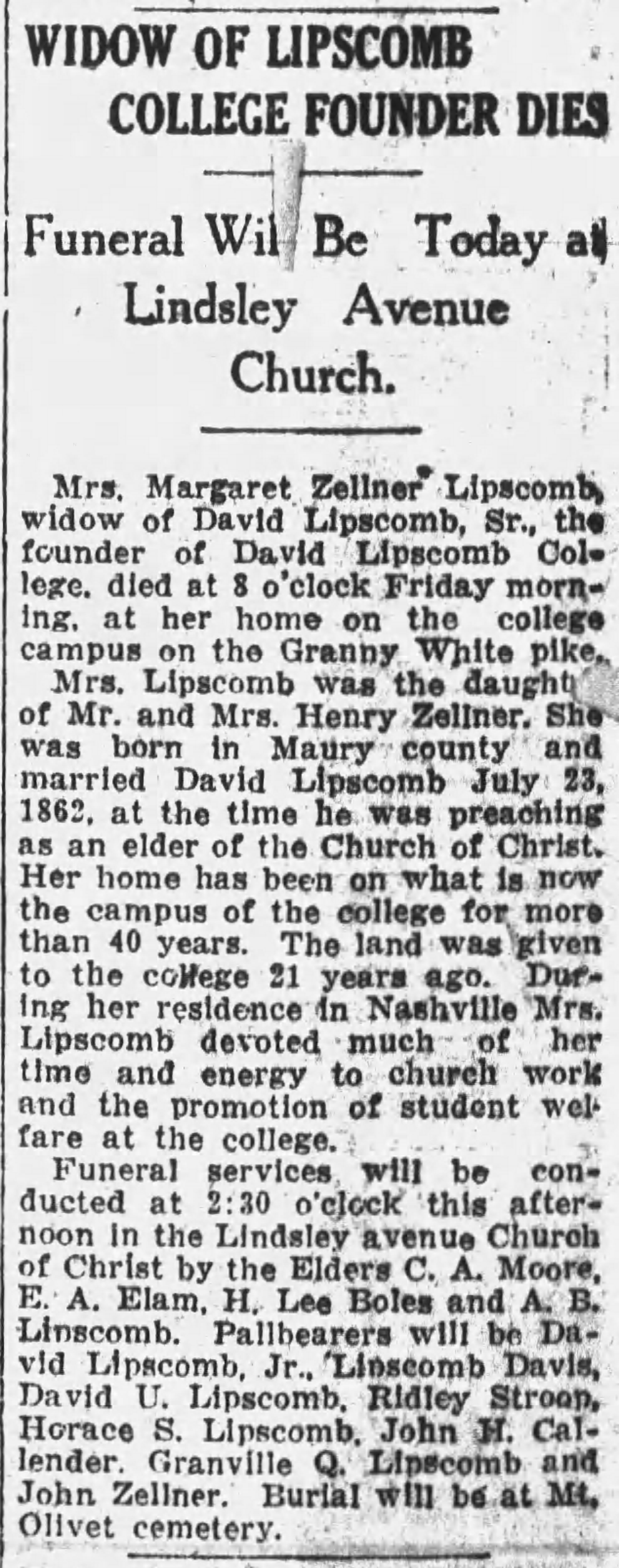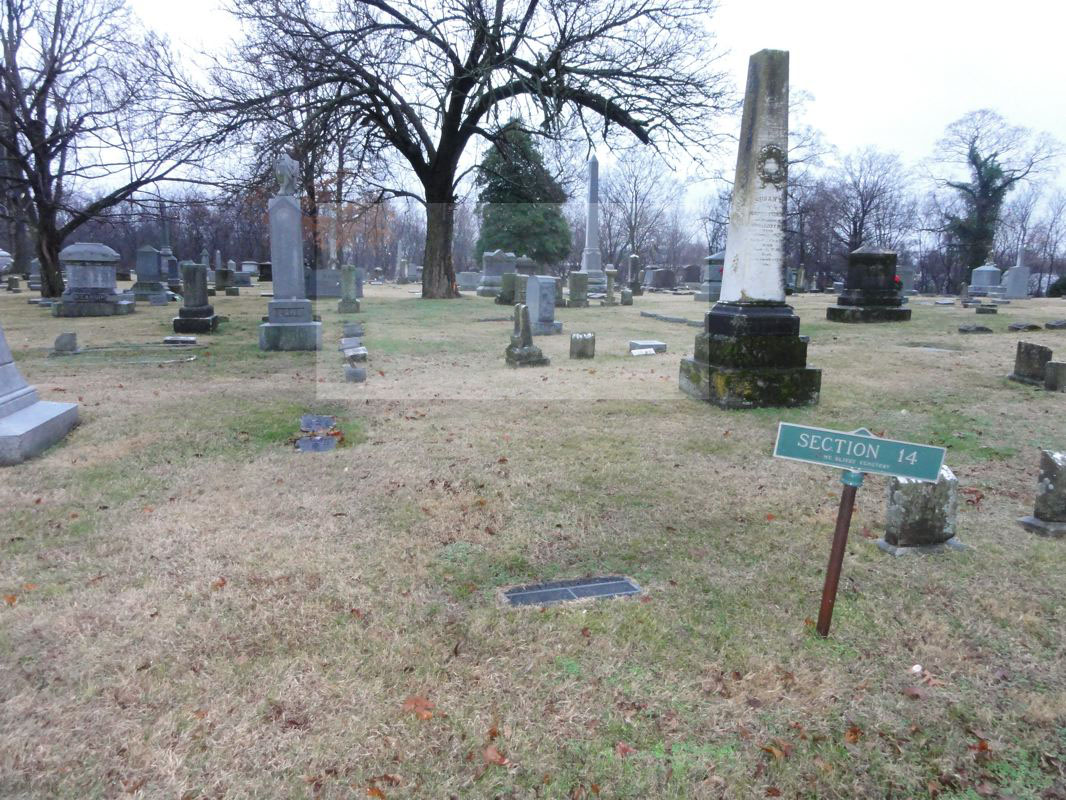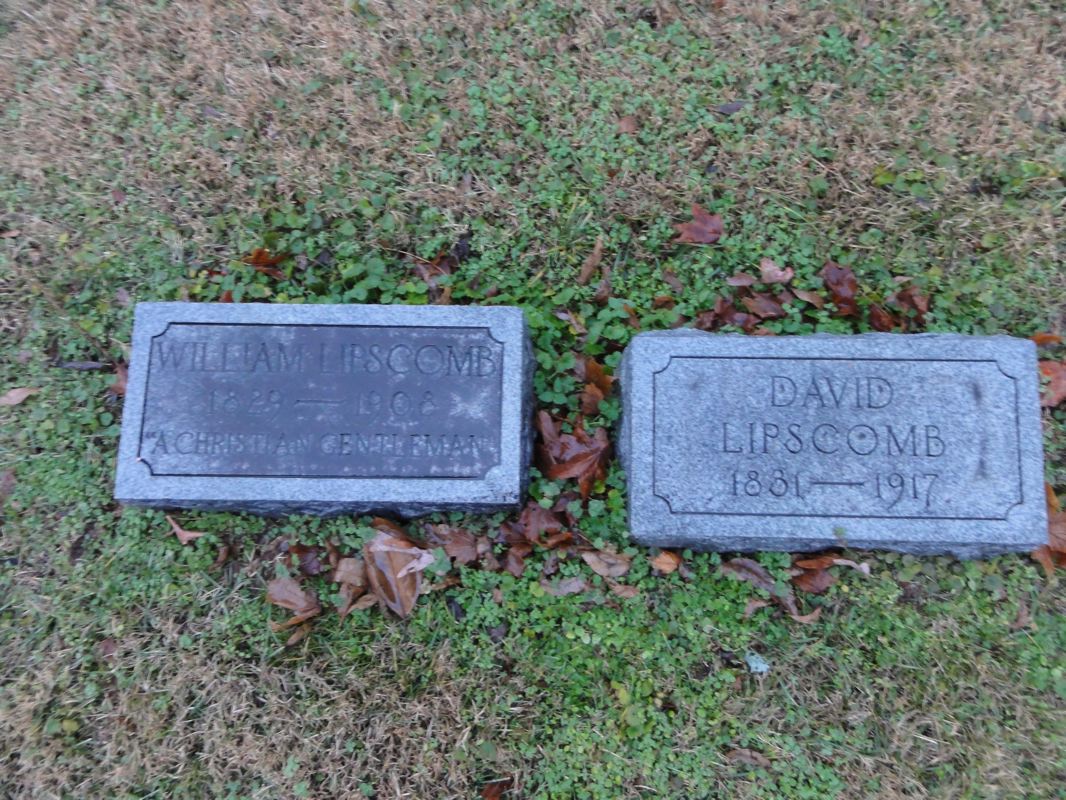David Lipscomb
1831-1917
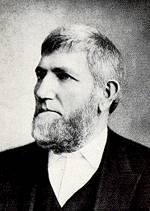
David Lipscomb
was born not far from Davy Crockett's Old Kentuck farm, on Bean's Creek, in the Old Salem
Community, Franklin County, Tennessee, January 21, 1831. His parents were
Granville and Ann Lipscomb. He, and his older brother
William, attended Franklin College in 1846 under
the tutelage of Tolbert Fanning, and he graduated in 1849.
After graduating he spent a couple years in Georgia, helping with family business. In
1852 he moved back to Franklin County, Tennessee and
helped in the building of the railroad between Nashville and Chattanooga. On
July 13, 1862 he married Margaret Zellner. One child was born to this union,
Zellner, born in September, 1863. He died at nine months of age from severe
dehydration from teething. He is buried in the Hughes Cemetery, off Santa Fe
Pike in Maury County, Tennessee. In 1866 David Lipscomb began
as co-editor of the Gospel Advocate with Tolbert Fanning. In 1891, with the help of
J. A. Harding and others, he founded the Nashville Bible School, now
Lipscomb
University. The university now sits on the old Lipscomb farm, Avalon,
on Granny White Pike, Nashville, Tennessee.
attended Franklin College in 1846 under
the tutelage of Tolbert Fanning, and he graduated in 1849.
After graduating he spent a couple years in Georgia, helping with family business. In
1852 he moved back to Franklin County, Tennessee and
helped in the building of the railroad between Nashville and Chattanooga. On
July 13, 1862 he married Margaret Zellner. One child was born to this union,
Zellner, born in September, 1863. He died at nine months of age from severe
dehydration from teething. He is buried in the Hughes Cemetery, off Santa Fe
Pike in Maury County, Tennessee. In 1866 David Lipscomb began
as co-editor of the Gospel Advocate with Tolbert Fanning. In 1891, with the help of
J. A. Harding and others, he founded the Nashville Bible School, now
Lipscomb
University. The university now sits on the old Lipscomb farm, Avalon,
on Granny White Pike, Nashville, Tennessee.
He was a very intelligent man who was soft spoken, but greatly convicted in his beliefs. He, by far, had more influence on the churches of the south through his work in the Gospel Advocate than any other preacher of the gospel during his lifetime. He died November 11, 1917 at the age of 86. Brethren, E.G. Sewell, J.C. McQuiddy, E.A. Elam, and C.A. Moore conducted the funeral at the College Street Church. He was laid to rest in the cemetery at Mt. Olivet. Through his efforts in the Gospel Advocate and Nashville Bible School, it could be said that he was the most influential man in the Restoration Movement in the Southern United States in the late 19th and early 20th centuries.
This brief summary of David Lipscomb's life is just to introduce an amazing man of God. Below you will find chronology of his life. At least two biographies have been produced on the life of David Lipscomb, one by Earl West and the other by Robert Hooper. At this writing they are still in print and can be obtained through the Gospel Advocate Company in Nashville, Tennessee.
-Scott Harp, 02.23.2020
![]()
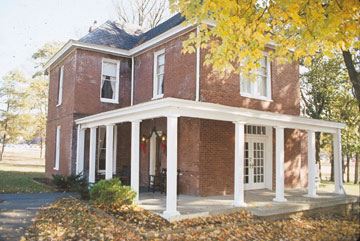
"Avalon" was the family home of
Uncle Dave and Aunt Mag Lipscomb. Sixty
acres were given to Nashville Bible School In 1902. It became the permanent home
of Lipscomb University in 1903.
![]()

![]()
Chronology Of The Life Of David Lipscomb
1800
Birth of Granville Lipscomb, father of David
1826
November
The Lipscomb family moves from Virginia to Bean’s Creek, Franklin
County, Tennessee – shortly after Granville’s wife, Ellen, and father
William, dies.
1828
Spring
Granville remarries Nancy, an older cousin from Virginia. (“Nancy”
according to Earl West, p.26; “Ann,” according to Hooper, p.20)
1829
June 20
William was born in Franklin County, Tennessee, Older brother to David
1831
January 21
David was born in Franklin County, Tennessee
1834
May
Beginning of the church of Christ at Old Salem, Franklin County,
Tennessee
1835
Spring
Father, Granville and Ann Lipscomb, moved family to Illinois to free slaves.
1836
Summer
Death of Nancy (Ann,) the mother of William and David Lipscomb in
Illinois. Also three small children, twin girls and a boy die. David was
5 years old
Nov./Dec.
Moved back to Tennessee. Purchased land deeded Dec. 1, 1836 (Hooper
states they returned to Tenn. in the fall of 1835, p.23).
1844
Barton W. Stone dies – Lipscomb never met him
1844-1845
David (14-15) and William “Billy” (15,16) go to Virginia to live with
maternal grandfather Lipscomb to be educated. Returned in December,
1845.
1846
January
Entered Franklin College in Nashville along with brother, William.
Greatly influenced by teaching of Tolbert Fanning (the second class
since its inception in 1845 – 136 pupils in the school that year – and
closed in 1861 with the beginning of the war.)
Summer
Tolbert Fanning baptizes David in a watering trough.
1848
June
William graduates from Franklin College
1849
Wed. October 17
Graduated from Franklin College.
October 23
American Christian Missionary Society begins in Cincinnati, OH
1849-1851
Managed a large plantation in Georgia – still unclear as to his future
1851
Fall
Returned to Franklin County, Tennessee
End Of Year
Returned to Nashville – Lived with brother, William
1852
April
Jesse B. Ferguson’s views on spiritualism shocks the brotherhood, and
especially young David Lipscomb
1853
November 16
Granville, father of David, dies at Beans Creek, buried in family
cemetery
1855
July 23
Secretary of cooperation meeting in Mountain District of Tennessee.
1856
End of year
Preached first sermon.
1857
Spent much of the year preaching around McMinnville, Tenn. Preaching –
then moved to Davidson County and purchased a farm with William
1858-1861
Preached mostly in central Tennessee and closer to Nashville
1859, 1860
The instrument added at Midway, Ky, marking the beginning of digression
in worship practices
1861
April
Outbreak of Civil War. Urged southern Christians not to participate.
December
Closing down of Gospel Advocate
due to cancellation of mail service and paper products.
1862
July 23
Married Margaret Zellner, One child, it died in infancy.
1862-1863
Winter
Taught School near Lawrenceburg
February 16
Opened school at Eagle Mills with eight students including William
Zellner, brother of Margaret
1864
Early in year
Moved to farm in Nashville
June 26
A son is born, Zellner (West, p.82); Hooper says he was born September
23, 1863 and died on June 26, 1864) p.83,84 – buried in Hughes Cemetery,
Maury County, in the Zellner plot.
1865
Early Spring
Zellner dies – No other children were born to the David and Margaret
April 9
General Lee surrenders at Appomattox, signaling the end of the Civil War
1866
January
Revived Gospel Advocate, which
had been forced to suspend publication during the Civil War, and became
its editor. Published long series of articles on the
Christian's relation to civil
government. Continued as editor of Gospel Advocate for more than
forty-five years.
March 4
Alexander Campbell dies in Bethany, W.V. – No info available saying his
path ever crossed with David Lipscomb
Spring
David was ill much of the time – stomach troubles
1866-67
Raised over $100,000 for destitute southern Christians.
1867
January
Added Philip S. Fall as a contributing editor to Gospel Advocate
Summer
Attended Kentucky State Meeting – met W.T. Moore and Thomas Munnell the
first time. Later a visit to Ohio where he met Isaac Errett, editor of Christian Standard in Cleveland. Also sought help for his
continuous stomach illness.
Written debate with Thomas Munnell on missionary societies.
1868
Oct./Nov.
Made a preaching tour in Georgia
1869
January
GA adds the prospectus of a new Kentucky paper, the Apostolic Times – not very
excited about having the competition, but acknowledged its presence. In
the 4 years of its publication,
GA saw American Christian Review in Anderson, Indiana and
Christian Standard in Columbia, later Cincinnati, OH as its major
competitors
September 20
E. G. Sewell (1830-1924) announced as associate editor of Gospel Advocate. Co-worker with Lipscomb for next forty years –
effective January 1, 1970
End of year
After a 1½ years of good health, stomach problems return
1870
Lipscombs move from Bell’s Bend to Edgefield to be nearer the offices of Gospel Advocate. Started a
congregation that met at Odd Fellows Hall.
April
Preaching trip to West Tennessee and Western Kentucky
December
Preaching trip to Hopkinsville, Ky
1872
January 15
Debate at Gallatin with Baptist: G.W. Griffin – Dr. T.W. Brents & E.G.
Sewell assisted Lipscomb
Moved back to farm at Bell’s Bend
May 27
Departs for 3 ½ month tour of Texas. Visited Galveston, Bryan, Houston,
Fort Worth, Waco, Dallas, Quitman.
1873-1874
Due to Cholera outbreak in the summer, ‘73, Lipscomb helped relieve the
poor in the city. As a result he comes down with the disease, and takes
much of the spring of ‘74 to overcome it – much hemorrhaging in the
lungs etc – a very sick man
1874
May 3
Tolbert Fanning dies after being gored by a bull some weeks earlier. Franklin College/Hope Institute closed after the end of the term, and remained closed for 10 years. Then in Sept. 1884, Fanning Orphan School opened, with DL on the board of trustees. That school continued for 60 years, ending in 1943. (TLWOCF, p.10)
1875
Met Benjamin Franklin, ed. Of
American Christian Review, for the first time when Franklin visited
Franklin, Tn in a meeting. – Represented the meeting of two giant
influences in the brotherhood. Franklin’s paper was often referred to as
the Gospel Advocate of the north.
Death of Anna Lipscomb, wife of William. Their children came to live in the David Lipscomb home at Bell’s Bend except son, David, who had moved in with his Uncle Dave and Aunt Mag five years earlier
1876
January
Moved back to Nashville
September
Moved back to Bell’s Bend for harvest time.
1878
October 22
Death of Benjamin Franklin, a blow to Lipscomb as he considered it a
loss of a great ally in the battle against organized societies.
Writes extensive article on re-baptism in GA —pages 678,679
December
Struck with a nearly fatal illness – a cold that turned to a constant
cough for two months. He thought his days were numbered. Well into
summer of ’79 before he began feeling well. Most work of year was
writing. Only began preaching again in August with visit back to Salem,
August 31
1880
June
Republican Convention, James A Garfield nominated president, much to the
disappointment of Lipscomb, due to his anti-involvement of Christians in
Civil matters; wrote editorials in GA against it, bringing strong
condemnation of Garfield supporters
1881
September 19
Death of President James A. Garfield, the object of much difficulty to
Lipscomb due to his ongoing stand against Christian involvement in civil
matters.
J.W. Higbee of Madisonville, Ky begins editing a column called, “Church, Field and Home” – The following year he steps down due to articles in Gospel Advocate denouncing the Missionary Societies, of which he was a proponent
Controversy over more than one loaf in the Lord’s Supper arose – discussed in GA, page 280 (1902-p.233 discusses more than one cup)
Fanning Orphan School is chartered. DL initiates the effort admonishing Charlotte Fanning to give the buildings of the Hope Institute with 160 acres to its founding. Though another year before starting, DL served as Chairman of the Board, not intially, but within a few years, for the remander of his life. (The school opened in Sept. 1884 and closed its doors in 1943) (TLWOCF, p.20; CITW, pps. 264,265)
1882
Gospel Advocate
begins inserting articles pro and con on the Temperance Movement
1883
Helps raise $10,000 for Fanning Orphan School. He and twelve others
constituted the Board of Trustees.
Purchase of 110 acre farm “Avalon” on the edge of Davidson County on Granny White Pike – Dairy farm – Moved there the following year – Lipscombs spend the rest of their lives there.
33% increase in circulation of Gospel Advocate
Parting of the ways of relationship between Gospel Advocate and Isaac Errett’s Christian Standard after editors publish letters of dispute over distribution of church hymnals.
1884
Fanning Orphan School established. DL, President of Trustees for rest of
life.
August, Sept.
Gospel Meeting at Winchester, Ky, home of James A. Harding, preached 17
sermons – also visited McGarvey and Grubb in Lexington and a trip to
Louisville
September
Beginning of Texas paper, Firm
Foundation by Austin McGary
- beginning with a long-running discussion on rebaptism,
embroiling both it and Gospel Advocate as mediums exposing the divergent views.
Fall
Added J.C. McQuiddy to GA as managing editor – officially beginning his
work with January, 1885 issue.
December 23
Departs for rest and preaching tour of Texas
1884-88
Struggle among Texas churches over missionary society question. Lipscomb
wrote extensively on the
questions of congregational cooperation and missionary organizations.
1885
January
J.C. McQuiddy joins editorial staff of Gospel Advocate as office and
managing editor / E.A. Elam began contributing articles—becoming front
page editor / Granville, younger half-brother of Lipscomb, was hired to
edit International Bible School Lessons
Spring
After return from Texas announced that GA was taking over
Texas Christian, a paper
edited by C.M. Wilmeth, bringing total of
GA subscriptions to 6700
December 14
2nd debate with Elder J.B. Moody (Missionary Baptist) at
Watertown, Wilson County, TN. J.M. Kidwell moderated for Lipscomb. On
Calvinism & Baptism – Lipscomb’s last debate
1887
Granville Lipscomb writes Sunday School material entitled Little Jewels – beginning the
years of GA produced Sunday School material
November 13
South Nashville church established. Lipscomb an elder for many years.
December
GA
announced 10,000 subscriptions; three times the amount since 1880
1888
January 1
Lipscombs place membership at South Nashville. Lipscomb served as an
elder here for many years.
1889
January
Gospel Advocate
articles on the Christian's relation to government published in
book form: Civil Government.
Spring
F.D. Srygley finishes his manuscript on Larimore and His Boys and
later printed by Gospel Advocate
April
Dr. D.M. Lipscomb, David’s uncle dies in Grapevine, TX
Gospel Advocate releases their first Christian Hymns volume
May 27
Served as moderator for James A. Harding in famous Nashville debate
between Harding and J.B. Moody (Baptist) – 16 nights – Over 100 people
baptized in Nashville area in following weeks
Summer
Beginning discussions with Harding about opening a school in Nashville
September 7
Jane Breeden Lipscomb dies – David’s step-mother
Fall of the year
F. D. Srygley became an editor of the Gospel Advocate. Next ten
years (1890-1900) were "golden
era" for the GA.
1890
June 29
Jesse L. Sewell died in Viola, TN and within one year David produced a
biography on his life.
F.D. Srygley produces Seventy Years In Dixie mostly on the life of T.W. Caskey
Tennessee Christian Missionary Society organized by A. I. Myhr in Chattanooga. Meeting meets in Nashville in 1891, 1892 – much to the discouragement of Lipscomb
Spring
Lipscomb produced a 64 page tract on Christian Unity, How Promoted And
How Destroyed, Faith And Opinion
Editorial debate with Austin McGary on the question of "rebaptism."
Fall
Tennessee State Missionary Society organized. National Society held
convention in Nashville in 1892. Lipscomb opposed both.
1891
April
Attended Missouri Christian Lectures at Huntsville. Delivered lecture on
civil government.
October 5
Nashville Bible School established on Fillmore St. with 9 students.
Faculty consisted of Lipscomb, Wm. Lipscomb,
and James A. Harding. Lipscomb
later wrote, "I have found more satisfaction in teaching the
Bible to the young men and women at school than in any work of my life."
James A. Harding serves as superintendent for the next ten years (never referred to as President, but is generally consider the 1st President)
Fall
Began being concerned at teaching of R. Lin Cave, son-in-law of W.H.
Hopson. His views on the Godhead led to parting of relationship with Lipscomb
by 1896
1893
April 11, Sunday
Suffered an accident when his horse drawn buggy was overturned as a
result if the horse being spooked as they were crossing a railroad
track. Lipscomb was severely hurt, being thrown from the buggy – His
recovery is slow.
Fall
J.W. Grant teaching math and Dr. J.S. Ward teaching Chemistry were added
to the faculty at NBS – third session of the school
Began authoring Gospel Advocate’s teachers comments in International Sunday School Lessons
Nashville Bible School has its first permanent location at cnr. Of South Spruce and Olympic Streets. Continued through Spring 1903 when campus moved to “Avalon,” present location of Lipscomb University
1894
June
Gospel Advocate
merges with Christian Messenger
August
Gospel Advocate
merges with Arkansas paper, The
Gospel Echo,
1895
Wrote numerous articles in Gospel
Advocate on Instrumental Music
1896
August 15
Charlotte Fall Fanning dies after being stricken some time with a
paralysis that kept her from speaking
1897
J. N. Armstrong added to the teaching staff at NBS
1899
Division in Nashville churches was complete. GA reports that the
Woodland St. church is most digressive in Tennessee. It and Vine St.
churches aligned themselves with society support, also adding the
instrument to their worship
November
Father-in-law Henry Zellner dies
1900
August 2
F. D. Srygley passed away
1901
January
E. A. Elam appointed Front-page editor of Gospel Advocate
Nashville Bible School is incorporated. David serves as its first Chairman of the Board of Trustees—Never serves as president of the college.
Summer
At the end of the 1900-1901 school year at Nashville Bible School, James A. Harding announces his departure for Bowling Green, Ky to begin Potter Bible College. William Anderson becomes 2nd Superintendent/President of NBS.
July
Alfred Ellmore merges his Gospel
Echo with Gospel Advocate
1902
Spring
Jesse P. Sewell added to the editorial staff of Gospel Advocate
60 acres of Avalon is given to the building of a permanent campus for DLC
1903
Gospel Advocate Publishing Company reorganized by forming the McQuiddy
Printing Company
Spring
Speaks to the last class of NBS at Spruce Street Campus
1904
March
Three buildings complete on Granny White Campus
For the next eighteen months DL appeared regularly on the witness stand for court case over the ownership of the Newbern, TN church building that had split over the instrument. Finally settled in favor of the instrument and society group in April, 1905.
1905-1906
William Anderson, Superintendent/President of Nashville Bible School dies suddenly. Dr. J. S. Ward becomes 3rd President in the interim.
1906
Census recognized reality of division between churches of Christ and
Disciples. J. W. Shepherd and Gospel Advocate collected statistics.
Franklin College And His Influences, edited by James Scobey is published
November
Offices of Gospel Advocate move to 317-19 Fifth Ave.
1906-1913
E.A. Elam becomes 4th President of Nashville Bible School - serves for six years
1908
DL's brother, William Lipscomb dies
1909
Death of Aunt Fannie Van Zandt. Lipscomb called her, “the mother of the
church at Fort Worth.”
Robert H. Boll appointed front-page editor of Gospel Advocate
1910
February
D. L.'s half-brother, Granville dies
1912
D. L. & E. G. Sewell sold interest in
Gospel Advocate to E. A. Elam,
M. C. Kurfees and A. B. Lipscomb.
1913
J. S. Ward becomes 5th President, only for interrim purposes
Fall
H. Leo Boles succeeds E. A. Elam as 6th President of NBS - serves until 1920, later serves from 1923-1932
1914
Boll begins writing articles on Premillennialism in Gospel Advocate
1915
June
R. H. Boll replaced by J.C. McQuiddy as Front Page editor due to his
premillennial views, but was temporarily reinstated later in the year
1916
January
Gospel Advocate
releases its 50th anniversary issue
1917
November 5
Suffered a paralytic stroke
November 11
Died at age eighty-six.
1918
Nashville Bible School officially recognized as David Lipscomb College
1920
H. Leo Boles resigns for NBH. A. B. Lipscomb appointed 7th President. His brother, Horace Swift Lipscomb is appointed Dean of Academics
1921
A. B. Lipscomb resigns and trustees appoint brother, H. S. Lipscomb as 8th President.
1923
H. S. Lipscomb resigns as President. H. Leo Boles enters his second term as 9th President - serves until 1932
1926
March 5
Margaret “Aunt Mag” dies
1932
H. Leo Boles resigns Presidency of DLC. Batsell Baxter is appointed 10th President.
1934
Batsell Baxter resigns Presidency. Trustees appoint E. H. Ijams as 11th President of DLC
1939
Burritt College, Spencer, Tennessee, closes after 91 years of existence (1848-1939)
1943
E.H. Ijams resigns over premillennial views. Batsell Baxter begins serving his second term as 12th President of DLC
Fanning Orphan School Closes after 61 years.
1946
At DLC, Batsell Baxter resigns Presidency — Athens Clay Pullias becomes 13th President.
1953
June 29
Earl West completes his introduction to the
Life And Times Of David Lipscomb
1977
At DLC - Athens Clay Pullias resigns Presidency — Willard Collins becomes 14th President
1979
November
Crying In The Wilderness: A Biography of David Lipscomb,
by Robert E. Hooper is released
1986
Willard Collins resigns as President of DLC; Harold Hazelip appointed 15th President.
1988
DLC gets university status - A new name of the institution is Lipscomb University
1997
Harold Hazelip resigns from Lipscomb University Presidency; Steve Flatt appointed 16th President
2005
Steve Flatt resigns Presidency of Lipscomb University; L. Randolph Lowry III appointed 17th President
2021
Dr. Candace McQueen becomes first woman and 18th President of Lipscomb University
CITW = Crying In The Wilderness: A Biography of David Lipscomb, by Robert E. Hooper
TLATODL=The Life And Times of David Lipscomb, Earl West
TLWOCF=The Life Work Of Charlotte Fanning, Emma Page
Sources Bibliography: Earl West, The Life and Times of David Lipscomb (1954), Robert E. Hooper, Crying in the Wilderness: A Biography of David Lipscomb (1979). https://www.lipscomb.edu/about/lipscombs-story/our-history; Books by Lipscomb: Civil Government, Commentary on Acts, Commentary on John, Commentary on the New Testament Epistles, Queries and Answers. by Bill Humble, with additions by Scott Harp - last updated 12.13.2022
![]()
Obituary for Margaret Zellner Lipscomb
The Tennessean, Nashville, Tennessee
Saturday, March 6, 1926, page 1
(click on article to zoom in)
![]()
Obituary For David Lipscomb
The Albany-Decatur Daily, Albany, Alabama
Monday, November 12, 1917, page 4
(click on article to zoom in)
![]()
Obituary For David Lipscomb
Nashville Banner, Nashville, Tennessee
Monday, November 12, 1917, page 16
(click on article to zoom in)
![]()
Directions To Lipscomb Graves
The David Lipscomb family plot is located in one of Nashville, Tennessee's oldest and most famous cemeteries, Mount Olivet. Many famous and wealthy Tennesseans such as, Thomas G. Ryman and others are buried there. To those in Churches of Christ, what makes this cemetery so famous are the numerous men and women of the Restoration Movement who are interred there. Lipscomb is buried in Section 14. The cemetery is located on Lebanon Pike in Nashville. From the city take I-40/24 to Exit 212/Fessler's Lane and turn left. Go down to the bottom of the hill and turn right on Lebanon Pike. The cemetery will not be far up on the right. If you are heading into town, take Exit 212 and turn right on Green, and it will run in to Lebanon Pike. Turn right on Lebanon Pike, and the cemetery will be up on the right. Nearly 40 Restoration Movement preachers are buried in this cemetery. Have a look at the map of where they are buried below.
GPS Coordinates to the Lipscomb Plot
36°08'49.0"N 86°44'03.4"W
or D.d. 36.146936, -86.734278
![]()
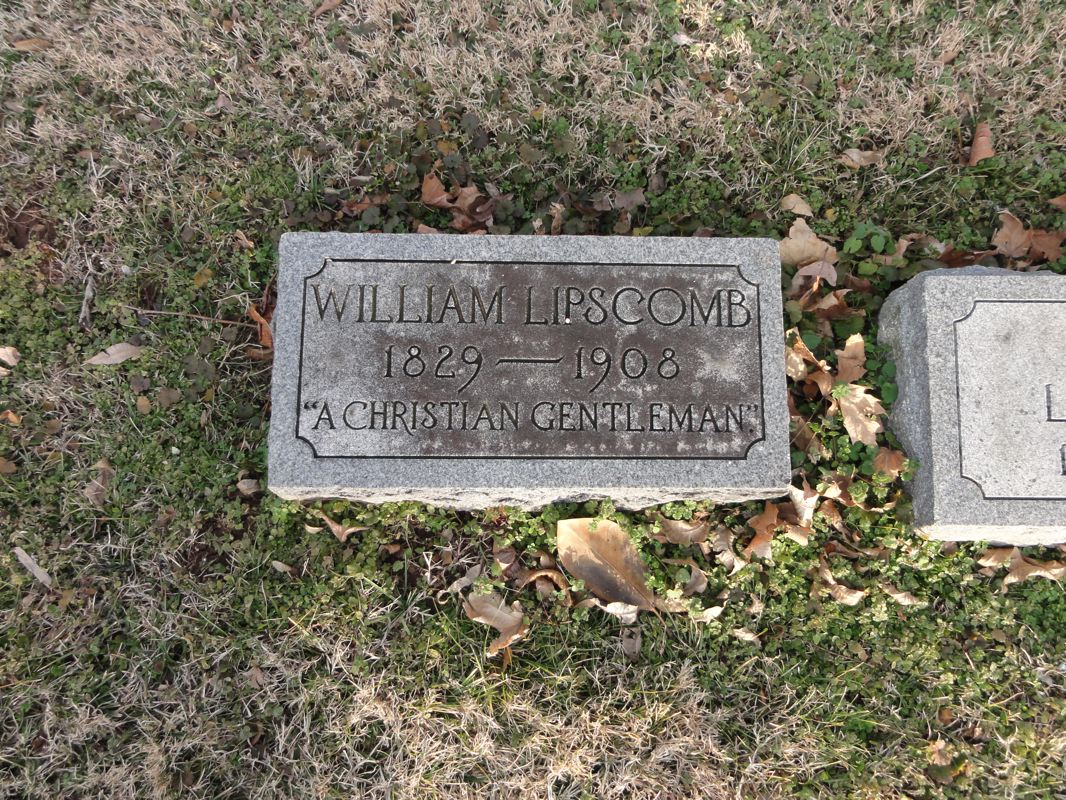
William Lipscomb
1829-1908
"A Christian Gentleman"
![]()
Some Links
Travel Map To Gospel Preachers Buried In Mt. Olivet Cemetery
David Lipscomb's Early Home Life And Parents
Biographical Sketch By H. Leo Boles
David Lipscomb at Find-A-Grave
Margaret "Aunt Mag" Lipscomb at Find-A-Grave
Zellner Lipscomb at Find-A-Grave
![]()
